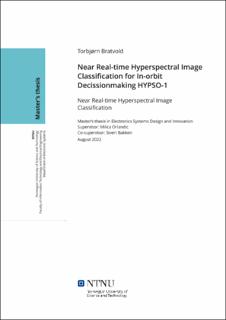| dc.contributor.advisor | Orlandic, Milica | |
| dc.contributor.advisor | Bakken, Sivert | |
| dc.contributor.author | Bratvold, Torbjørn | |
| dc.date.accessioned | 2022-11-12T18:19:35Z | |
| dc.date.available | 2022-11-12T18:19:35Z | |
| dc.date.issued | 2022 | |
| dc.identifier | no.ntnu:inspera:104140281:34092916 | |
| dc.identifier.uri | https://hdl.handle.net/11250/3031514 | |
| dc.description.abstract | With the launch of the HYPSO-1 hyperspectral imaging research small satellite in February of 2022. Improvements in processing technology has made on-board processing of larger amount of data feasible on such small computational platforms. For the HYPSO-1 satellite today the biggest bottleneck is how much data that can be sent over the radio-link. This work aims to create a novel machine learning model for near real-time classification of hyperspectral images. The model takes advantage of the way the HYPSO-1 captures image cubes one spatial line at a time to achieve near real-time classification. This way larger autonomy can be given to the satellite to decide when image captures should be initiated and which images should be prioritised for downlink.
An exprimentational approach lead to the building and training of a model capable of achieving 95.0\% accuracy when classifying land, clouds and water on a chosen self labelled raw HYPSO-1 capture with no pre-processing or radiometric calibration. The model experiments with using graphical convolutional layers instead of the more conventional convolutional neural network. The model was built using the Python framework PyTorch and PyTorch Geometric. The model was also tested with the standard hyperspectral datasets Indian pines and SalinasA to gauge a more general performance of the model. | |
| dc.description.abstract | With the launch of the HYPSO-1 hyperspectral imaging research small satellite in February of 2022. Improvements in processing technology has made on-board processing of larger amount of data feasible on such small computational platforms. For the HYPSO-1 satellite today the biggest bottleneck is how much data that can be sent over the radio-link. This work aims to create a novel machine learning model for near real-time classification of hyperspectral images. The model takes advantage of the way the HYPSO-1 captures image cubes one spatial line at a time to achieve near real-time classification. This way larger autonomy can be given to the satellite to decide when image captures should be initiated and which images should be prioritised for downlink.
An exprimentational approach lead to the building and training of a model capable of achieving 95.0\% accuracy when classifying land, clouds and water on a chosen self labelled raw HYPSO-1 capture with no pre-processing or radiometric calibration. The model experiments with using graphical convolutional layers instead of the more conventional convolutional neural network. The model was built using the Python framework PyTorch and PyTorch Geometric. The model was also tested with the standard hyperspectral datasets Indian pines and SalinasA to gauge a more general performance of the model. | |
| dc.language | eng | |
| dc.publisher | NTNU | |
| dc.title | Near Real-time Hyperspectral Image Classification for In-orbit Decissionmaking HYPSO-1 | |
| dc.type | Master thesis | |
